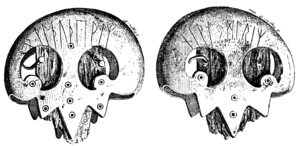Odal (rune)
This article's lead section may be too short to adequately summarize the key points. (March 2021) |
| Name | Proto-Germanic | Old English |
|---|---|---|
| *Ōþalan | Ēðel | |
| "heritage, estate" | ||
| Shape | Elder Futhark | Futhorc |
| Unicode | ᛟ U+16DF | |
| Transliteration | o | œ |
| Transcription | o, ō | œ, oe, ōe |
| IPA | [o(ː)] | [eː], [ø(ː)] |
| Position in rune-row | 23 or 24 | |



The Elder Futhark Odal rune (ᛟ), also known as the Othala rune, represents the o sound. Its reconstructed Proto-Germanic name is *ōþalan "heritage; inheritance, inherited estate".
It was in use for epigraphy during the 3rd to the 8th centuries. It is not continued in the Younger Futhark, disappearing from the Scandinavian record around the 6th century, but it survived in the Anglo-Saxon Futhorc, and expressed the Old English œ phoneme during the 7th and 8th centuries. Its name is attested as ēðel in the Anglo-Saxon manuscript tradition. The odal rune with serifs (feet) is associated with Nazism and is banned in Germany under laws restricting Nazi symbolism, and other, similar organizations.
The rune is encoded in Unicode at code point U+16DF: ᛟ.
Name and etymology[]
The Common Germanic stem ōþala- or ōþila- "inherited estate" is an ablaut variant of the stem aþal-. It consists of a root aþ- and a suffix -ila- or -ala-. The suffix variant accounts for the umlauted form ēþel. Germanic aþal‑ had a meaning of (approximately) "nobility", and the derivation aþala‑ could express "lineage, (noble) race, descent, kind", and thus "nobleman, prince" (whence Old English ætheling), but also "inheritance, inherited estate, property, possession". Its etymology is not clear, but it is usually compared to atta "father" (cf. the name Attila, ultimately baby talk for "father").
There is an apparent, but debated, etymological connection of Odal to Adel (Old High German adal or edil), meaning nobility, noble family line, or exclusive group of superior social status; aristocracy, typically associated with major land holdings and fortifications.[1][self-published source?]
The term oþal (Old High German uodal) is a formative element in some Germanic names, notably Ulrich and variants;, the stem aþal is more frequent, found in Gothic names such as Athalaric, Ataulf, etc. and in Old High German names such as Adalbert,[2] and Adel. Unrelated, but difficult to separate etymologically, is the root aud- "wealth, property, possession, prosperity";[3] from this root are names such as Edmund and other English names with the ed prefix (from Old English ead), German Otto and various Germanic names beginning with ed- or od-. Possibly related is euþa, euþu a word for "child, offspring" (attested in Old Norse jóð, and possibly in the name of the Iuthungi).
Odal was associated with the concept of inheritance in ancient Scandinavian property law. Some of these laws are still in effect today, and govern Norwegian property. These are the Åsetesrett (homestead right), and the Odelsrett (allodial right). The tradition of Udal law found in Shetland and Orkney in Scotland, and also in Manx law on the Isle of Man, is from the same origin.
Elder Futhark o-rune[]

The o-rune is attested early, in inscriptions from the 3rd century, such as the Thorsberg chape (DR7) and the Vimose planer (Vimose-Høvelen, DR 206). The letter is derived from a Raetian variant of the letter O.[citation needed] The corresponding Gothic letter is